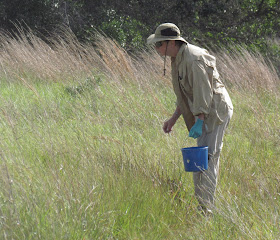I took a day off from work to go on a seed collecting trip. We could either keep the seeds we collected, for our own projects, or give them to the plant guys at Armand Bayou Nature Center where volunteers grow seeds from seed to rebuild a prairie from land they are wresting from tallow trees, a major invasive problem in east Texas. We went to Brazos Bend State Park which is managing a 400 acre Indiangrass-little bluestem tall grass coastal prairie through periodic prescribed burning and mowing.
Some of us carpooled from Houston and others met us at the park. Tom Solomon, our leader, led us out into the prairie and showed us what brownseed paspalum looks like. It grows in little clumps among other grasses and we had to practice seeing it for a few minutes. We also compared it to vasey grass,another paspalum species, that is an invasive weed that is of concern in Texas and some other states. And we were to follow the rule of taking twenty percent of the seeds and leaving the rest. We also stripped the seed from the stems and the wind took some of it so we helped distribute the seed in its home prairie.
 |
| Starting out with our paper bags |
 |
| The inflorescence (seed head) we were looking for |
Brownseed paspalum (
Paspalum plidatulum) is a warm season grass that grows in sandy to mineral clay moist soils. It provides nesting cover for bobwhite quail and food for bobwhites and turkeys. It is the larval host of the bunchgrass skipper.
 |
| The prairie where we hunted |
 |
| The hunt position |
We also visited the Nash and Mowotony Prairies after we collected seeds. Several of us collected the seeds of green milkweed there and I enjoyed taking pictures of some of the prairie forbs. We learned that the Nash Prairie has never been plowed so it has all the grasses and forbs that it has historically. But it is threatened by the terribly invasive tallow trees. It gets mowed and burned to protect it.
 |
| Yellow-Puff (Neptunia lutea) |
I don't remember seeing this plant and thought it must be related to the sensitive briar, a plant that has leaves like this one but pink fuzzy balls, but it is in a different genus. The leaves react to touching by closing in the same way, though.And the next day, I found a plant growing at the base of one of our new trees at Anahuac NWR.
 |
| Green Wild Indigo ( Baptisia sphaerocarpa) |
 |
| Rattlesnake Master (Button Eryngo), a prairie indicator species |
Rattlesnake master was very abundant in the Nash Prairie. It is an indicator of a intact prairie.
 |
| Green Milkweed (Asclepias viridis) |
This is the most common milkweed of the coastal prairie and I actually took this picture along Hwy. 1985, the road that brings you to Anahuac NWR. But I collected seeds on the Mowotony Prairie from green milkweed that I need to get planted. We'll put the plants in the Monarch/Queen section of the butterfly garden.
If you are interested in learning more about prairie remnants in Texas, check out the
Native Prairies Association of Texas.








No comments:
Post a Comment